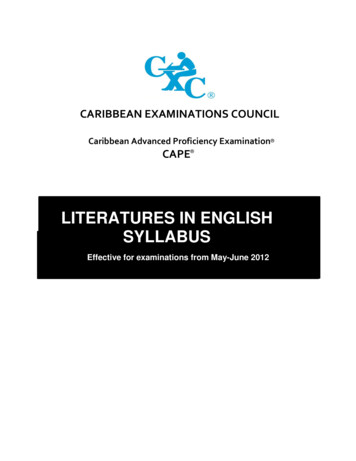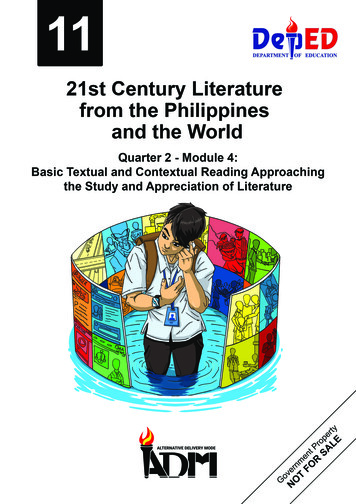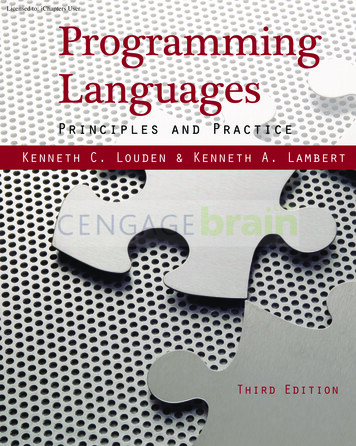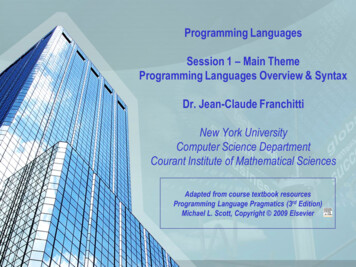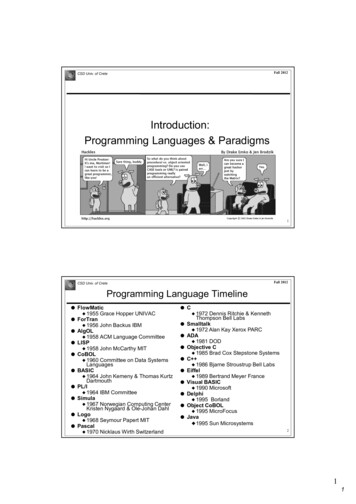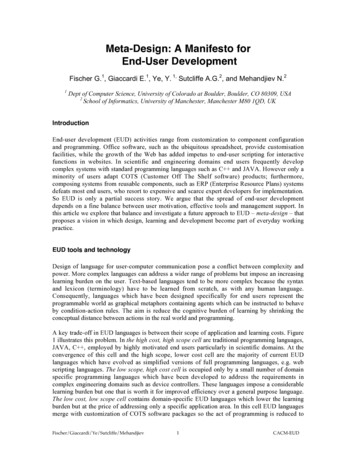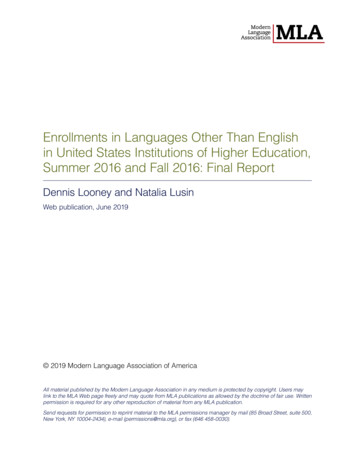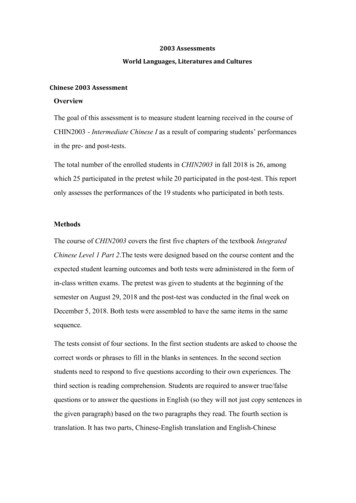
Transcription
2003 AssessmentsWorld Languages, Literatures and CulturesChinese 2003 AssessmentOverviewThe goal of this assessment is to measure student learning received in the course ofCHIN2003 - Intermediate Chinese I as a result of comparing students’ performancesin the pre- and post-tests.The total number of the enrolled students in CHIN2003 in fall 2018 is 26, amongwhich 25 participated in the pretest while 20 participated in the post-test. This reportonly assesses the performances of the 19 students who participated in both tests.MethodsThe course of CHIN2003 covers the first five chapters of the textbook IntegratedChinese Level 1 Part 2.The tests were designed based on the course content and theexpected student learning outcomes and both tests were administered in the form ofin-class written exams. The pretest was given to students at the beginning of thesemester on August 29, 2018 and the post-test was conducted in the final week onDecember 5, 2018. Both tests were assembled to have the same items in the samesequence.The tests consist of four sections. In the first section students are asked to choose thecorrect words or phrases to fill in the blanks in sentences. In the second sectionstudents need to respond to five questions according to their own experiences. Thethird section is reading comprehension. Students are required to answer true/falsequestions or to answer the questions in English (so they will not just copy sentences inthe given paragraph) based on the two paragraphs they read. The fourth section istranslation. It has two parts, Chinese-English translation and English-Chinese
translation. The maximum possible points of both tests are 87.In this assessment we first compared the overall results of both pre- and post-tests foreach student to determine their improvement. We also conducted a comprehensivereview across each section the post-test to see if students performed better in somesections than others. With this information, instructors could make alternation in theirteaching to improve identified weaknesses or use the information about studentstrengths as the evidence of effective teaching.ResultsStudents’ Overall PerformancesFigure 1. Comparison of Individual student overall performances in the Pre- and Post-testsAs Figure 1 shows above, all students performed better in the post-test. In the pretest,only one student (S 9) passed the test (the passing score is 87*60% 52.2, and S 9’sscore is 76). This student comes from Singapore and she grew up using Chinese, so itis not surprising that she scored as high as 75 in the pretest. In the post-test, 11students scored more than 90% of the possible points (87*90% 78.3), 13 students
scored more than 80% of the possible points (87*80% 69.6), 14 students scored morethan 70% of the possible points (87*70% 60.9), and 15 students scored more than60% of the possible points (87*60% 52.5). Four students failed the post-test, but theyall made some improvements.The average points of the pretest are 30.3 and the average points of the post-test are70.7, which shows an increasing rate of 133%. It’s safe to say that students’ readingand writing skills significantly improved through course learning and instruction.Students’ Performances in Section 1Section 1 gives students ten words/phrases and asks them to choose the correct onesto fill in the blanks in sentences. This section is designed to test students’understanding of the key words and phrases they have learned in CHIN2003 and ofhow those words and phrases work with other sentence elements.Figure 2. Student Individual Performances on Section 1As indicated above, all students did better in the post-test than in the pretest. Thereare14 students who received full points in this section and the average points are 8.79out of 10.
Students’ Performances in Section 2Section 2 asks students five questions and students should answer those questionsaccording to their own experiences. The objective of this section is to test students ifthey could understand questions with certain grammatical structures and if they couldmake appropriate responses. Students are required to write their responses incharacters. Therefore, this section examines students’ abilities of writing characters aswell.Figure 3. Student Individual Performances on Section 2Figure 3 shows students’ performances on Section 2. All students scored higher in thepost-test than in the pretest except S 11 and S 12. They received the same points in thepretest and the post-test. The average points students obtained on Section 2 are 11.74out of 15, and only three students received full points of 15. One of the reasons thatstudents did not perform as well on Section 2 as they did on Section 1 could be that inSection 2 students had to produce language output while in Section 1 students onlyneeded to pick a given word or phrase to fill in a blank in a given sentence, whichinvolved zero output. Another reason could be that students had to write characters inSection 2, which is well-known to be challenging to native English speakers.
Students’ Performances on Section 3Section 3 is reading comprehension, which only tests students’ reading proficiency.Students’ language output is not required in this section. Students will read twoparagraphs. They need to answer five true/false questions to five statements based onthe first paragraph and they are going to answer five questions after they readParagraph 2. The questions are in Chinese but students will answer them in English.Figure 4. Student Individual Performances on Section 3Based on the information presented in Figure 4, one can see that students showedbetter performances on Section 3 than on Section 2. The average points in thepost-test are 21.63 out of 25, which make the accuracy of 86.4%, while the averageaccuracy on Section 1 and 2 in the post-test is 88% and 78%, respectively.All students made improvements in the post-test. However, the differences betweenthe pretest and the post-test on Section 3 were not as obvious as those on othersections. Because in the pretest, students did noticeably better on Section 3 than onother sections. The average accuracy on Section 3 in the pretest is as high as 56.8%(14.21 out of 25), while this data is 34% in Section 2 and 26.8% in Section 1.The fact that students did better on Section 3 in the pretest than on the other sections
could be explained as the following. In Section 3, students are provided withparagraphs instead of unrelated single sentences. Therefore, they will inevitablyencounter many words and phrases they learned in Elementary Chinese, which revealsto students a certain amount of information that they can rely on to sort out thegeneral idea of the passage.In the post-test, however, students did not do as well on Section 3 as on Section 1.This result was expected since reading passages in Chinese characters could beintimidating and overwhelming, especially during an exam. It is easy to overlooksome details when students have to deal with a great amount of information.Students’ Performances on Section 4 Part 1- Chinese into English TranslationIn this part, students were given three Chinese sentences with some grammarstructures and vocabulary they will learn or learned in CHIN2003. It looks likeanother reading comprehension section, but sentence translation examines students’understanding of certain language elements more specifically.Figure 5. Student Individual Performances on Section 4 Part 1 - Chinese into English TranslationAs Figure 5 shows, the average points students received on Section 4 Part 1 were10.68 out of 12, which makes the accuracy 89%, the highest across all sections. One
can also see the greatest improvement among all the sections since the averageaccuracy on Section 4 Part 1 in the pretest is only 18% (2.16 out of 12). There are 5students who did not get any point in the pretest, but in the post-test, 3 of themreceived full points of 12.As discussed above, this part was designed to aim specifically at vocabulary andgrammar structures students will learn or have learned in CHIN2003. The result in thepretest was fully expected and the result in the post-test could be used as the evidenceof successful acquisition and effective teaching.Students’ Performances on Section 4 Part 2- English into Chinese TranslationIn this part, students are required to translate five English sentences into Chinese andthey need to hand-write their answers in characters. This part examines students’grasp of the usage of the vocabulary and grammar structures taught in CHIN2003, andat the same time, tests students’ character writing skills.Figure 6. Student Individual Performances on Section 4 Part 2 English into Chinese TranslationAs shown above, all students made improvements in the post-test on Section 4 Part 2except S 19 who got 12 points in both tests. The average points students scored onthis part are 18.68 in the post-test, and the average accuracy is 74.7%, the lowest
among all sections. No one received full points. The average accuracy in the pretest is19.6% (4.89 points out of 25), a little higher than the accuracy on Section 4 Part 1 inthe pretest.This part requires students to produce output based on the given English sentences. Ithas been proven to be the most difficult part of the test. There are two reasons whythis part is more difficult than Section 2. The first one is that the questions in Section2 are of great assistance in students’ output. Because in Chinese, the sentence orderdoes not change in questions, students only need to identify the question pronouns andsimply replace them when answering questions. The second reason lies in the fact thatstudents enjoy a certain degree of freedom to pick the words they know whenanswering questions in Section 2. For example, to answer the question “Where do youoften put the fruits you buy?”, if a student does not remember the word for“refrigerator”, he/she can change the answer from “in the refrigerator” into “on thetable”. However, in Section 4 Part 2, students will have to translate the givensentences, which leaves them little space to bypass the words or structures they do notknow or remember. The common situation is that they either know how to translate asentence, or they don’t.Final ThoughtsBoth students’ overall performances and their performances in each section in the twotests have shown significant improvements in their Chinese reading and writingproficiency. To give a holistic assessment of learning outcomes and teachingeffectiveness, the future pre- and post-tests should also incorporate sections thatexamine listening and speaking skills.Although every student’s points increased in the post-test, the fact that 5 studentsreceived lesson than 70% of the points should not be neglected. The Chinese programhas been trying to offer additional help to students by organizing Chinese Lab,
Chinese Conversation Table and Peer Tutoring sessions, etc. Instructors canencourage those students to take advantage of those resources.The last thought concerns Chinese characters teaching. Among those 5 students whoreceived less than 70% of the points, 2 of them (S 13 and S 19) are heritage students whohave comparatively high speaking proficiency. It’s obvious that characters are theobstacles for them to reach a higher level of reading and writing. Unfortunately, theircharacters did not improve much after one semester’s learning while other heritagestudents (S 6, S 10, S 15, and S 16) demonstrated a more advanced level of literacy at theend of the semester. It is definitely worth thinking about how to motivate students andraise their interest in character learning.
French 2003 AssessmentOverview:The Assessment Exam, intended to gather data for the study, was given twice during thesemester: the first time during the second week of class, on January 23, 2019, and the secondduring the last full week of class, on April 22, 2019. Thus students were tested approximatelythree months apart, at the beginning and the end of the course. Students were apprised of thenature of the exam and its purpose, and were requested to take the exam seriously, although itwas not for a grade. To maximize participation, a small percentage of their final grade wasbased on simple completion of both exams; for the same reason, the exam was given in class,and had every appearance of a typical exam in the course. It had been suggested that an exam onBlackboard might accomplish our goals, but the test planners adjudged that students might nottake seriously an exam in such a format. Our belief was that if it had every appearance of anormal exam, students might unconsciously take it more seriously, and give their best effort.Assessment Instrument:The Assessment Instrument for the exam was based upon the final exam of the precedingcourse (French 1013 – Elementary French II). The test planners made an effort to eliminatesubjectivity in evaluating students’ performance, and therefore eliminated the writing or“composition” section from the exam. Most other elements of the French 1013 final wereretained: reading section, listening comprehension section, and lengthy grammar section.To create an Assessment Instrument that could be completed in a 50-minute period, aswell as one that could be objectively graded, the planners changed the format of student answers.On the French 1013 final, grammar is tested by a variety of means, but all require student input:fill in the blank of verb forms or vocabulary, rewriting of sentences using negation or pronouns,question construction, and so forth. For the Assessment Instrument, the planners converted thegrammar sections to “recognition-only,” using a multiple-choice format. Students did not haveto produce correct grammar forms; rather they identified correct forms in a pool of four answers.Only one answer was correct for each item, with a variety of incorrect or ‘distractor’ answers.Although this approach might be considered a simplified one, it enabled objective grading, andsince it was employed on both exams, the students’ task was the same each time. The plannersexpected this to provide an accurate baseline for the results.In the interest of objective grading, the planners provided Scantron forms to the students. Theexperts at Gibson Annex ran the forms for our Department, providing us with the data thatfollows.Results of First Assessment Exam:The number of students tested and the mean percentage results are as follows:Section:001Enrollment:9Mean Percentage per section:46.22 %
0021362.84 %0031351.92 %004950.56 %0051352.92 %Results of Second Assessment Exam:The number of students tested remained the same. The mean percentage results are as follows:Section:Enrollment:Mean Percentage per section:001952.25 %0021371.36 %0031357.64 %004953.78 %0051360.15 %Comparison of Results of the two Assessment Exams:The results side-by-side and the variance are as follows:Section:Mean, Exam I:Mean, Exam II:Variance:00146.22 %52.25 % 6.03 %00262.84 %71.36 % 8.52 %00351.92 %57.64 % 5.72 %00450.56 %53.78 % 3.22 %00552.92 %60.15 % 7.23%Thus, the mean variance across the five sections was 6.14 %. Students scored over sixpercentage points better on the same exam after taking the course.Conclusion:This variance is positive, and we see improvement across all sections. The clearconclusion is that students perform better at recognition of basic structures and vocabulary inFrench after completing French 2003.
That we do not find greater improvement than an average of just over six percent couldbe attributed to several factors. In January, many students who enrolled in French 2003 had littlemore than a month previously taken the French 1013 final; perhaps it was still somewhatfamiliar, creating falsely high first results. Another possible factor is that while some of thebasic structures students learn in French 1013 are specifically reviewed in French 2003, not allare; moreover, new concepts and structures are introduced. Clearly, what is new in French 2003could not be tested before the first assessment exam; doing so would create a falsely low firstresult. The planners decided that using a modified French final 1013 exam would set a baselinefor determining what students knew upon enrolling in the course. Of course, the two assessmentexams had to be the same. The result of this necessity is that the second assessment exam testsmaterial that may not be explicitly taught in French 2003, although it tests material that isessential to learning French.The planners hope to develop improvements to the testing format before the next BiAnnual Assessment, in order to diminish the factors mentioned above. It may be that the studyof practices of other departments in the University or language departments in other institutionswill enable us to improve our methods in the future. We welcome any comments or suggestions.
German 2003 AssessmentSince Spring 2018, we have conducted pre- and post-assessments in GERM 2003, IntermediateGerman I, in accordance with the university’s recent requirement that university core courses beassessed to measure student progress. To this end, the faculty in the German section created a two-partexamination designed to assess students’ knowledge of grammar, vocabulary, and culture in the firstmultiple choice “written” section, and students’ listening and speaking abilities in a second recordedinterview. The same assessment was given to students at the beginning and end of the semester tomore accurately reflect change across the duration of the course. We have administered the assessmenttwice (Spring and Fall 2018), but are still working on refining the testing process (due to issues with thesoftware, for example, several students had difficulty recording their oral interviews, thus leavingincomplete data from pre- to post-assessment; additionally, the assessment is not mandatory, and assuch has inconsistent participation). Summary of findings: the data suggest that students are makingimprovement in both written and oral skills from the beginning of GERM 2003 to the end, though thereis room for greater improvement. The assessment has not yet yielded sufficient data, however, toidentify trends in student performance. In order to make concrete changes to the curriculum at thislevel, it will be useful to develop a more precise assessment module and rectify the issues preventingsome students from completing both pre- and post-assessments in either written or oral proficiency.Below are the results from the last two assessment periods:Spring 2018Pre-Assessment28/36 passed written (78%)30/30 passed oral (100%)The average score for writing was 68%; the average score for speaking was 83%.Post-Assessment32/34 passed written (94%)22/22 passed oral (100%)The average score for writing was 76%; the average score for speaking was 84%. From pre- to postassessment, students improved an average of 8% in writing, and 1% in listening, while the passing rate inwriting increased by 16%. The minimal improvement in oral proficiency may be due to a sharp drop incompletion of the oral component on the post-assessment.Fall 2018Pre-Assessment37/47 passed written (79%)20/20 passed oral (100%)
The average score for writing was 66%; the average score for speaking was 95%.Post-Assessment24/31 passed written (77%)22/24 passed oral (92%)The average score for writing was 69%; the average score for speaking was 91%. From pre- to postassessment, students improved 3% in writing, but dropped 4% in listening. The latter value is due in partto an increase in participation on the oral component during the post-assessment, which introducedstudents with weaker scores than those who had completed the oral pre-assessment. The passing ratefor both modules dropped from pre- to post-assessment, but we have yet to identify specific areas forincreased focus in the written assessment.
Italian 2003 AssessmentItalian 2003 Assessment, Fall 2018Dr. Rozier and Mr. Anthony Sargenti gave a short True/ False, Multiple Choice and Writing preassessment test on August 24th; the post-assessment test was given on December 3rd. There were2 sections of ITAL 2003, with 30 students. Students completed exercises to evaluate their skillsin listening comprehension, vocabulary, grammar, reading and writing (T/F and short answers),and ultureTotalPre-Assessment Score51%46%31%59%56%42%Post-Assessment %Improvements were made in all categories. Going forward we will change the cultural exercisefrom T/F to multiple choice or short answer, since there could be false positives in the preAssessment.A copy of the assessment is included.
The course of CHIN2003 covers the first five chapters of the textbook Integrated Chinese Level 1 Part 2.The tests were designed based on the course content and the expected student learning outcomes and both tests were administered in the form of in-class written exams.
